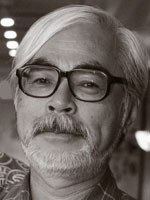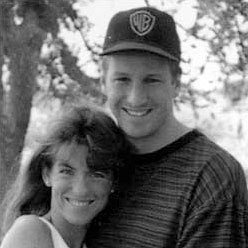Joe Strike hits the streets of New York to discover the new wonder from Japan care of animation master Hayao Miyazakis Howls Moving Castle.

Howls Moving Castle is perhaps Miyazakis most phantasmagorical film filled with astonishing imagery and supernatural logic. But will Americans get it? All images © 2004 Nibariki. GNDDT. All rights reserved.
For Hayao Miyazaki, it is a return to a land he knows very well. For everyone else, it is a visit to a world of marvels.
Howls Moving Castle, like several of Miyazakis other films, takes place in a world where magic is commonplace and Edwardian-era technology has spawned massive aerial warships. And like those films, it centers on a young woman who resolutely faces a challenge that might leave a conventional movie hero dazed and confused.
Howls North American premiere at New York Citys Museum of Modern Art on June 6, 2005, was an opportunity for its creators and American adaptors to run a media gauntlet of microphones, video cameras and tape recorders. First in line was Miyazaki himself, followed closely by his translator and his producer Toshio Suzuki.
The Japanese media had the edge in sharing the directors language, and were rewarded with longer and presumably more nuanced answers to their questions. His (or his interpreters) English-language responses were concise and tended on occasion towards the tongue-in-cheek. (An aspiring animator was advised to be poor, be young and have no name. Thats the best way to become a great creator thats what Mao Tse-tung said.) When asked if he was surprised by the acceptance and acclaim his work has garnered in the U.S., Miyazaki replied they may change their minds when they see this film.
Howls Moving Castle is perhaps Miyazakis most phantasmagorical film yet, surpassing even Spirited Away in its astonishing imagery and supernatural logic. In the films first few minutes, blobby tar baby demons wearing straw hats bubble out from beneath paving stones and retreat en masse into a tiny teapot a wizard rescues a damsel in distress by taking her for a stroll in mid-air the eponymous construction, a haphazard heap of cottages, turrets and decrepit machinery is glimpsed through misty clouds, striding on a quartet of gigantic mechanical bird legs and a goiter-necked witch transforms a young girl into a wizened old woman.
Transformation is a recurring theme in Studio Ghiblis films, from Spirited Aways piggish parents and The Cat Returns whisker-sprouting heroine, to Porco Rossos pig-headed aviator. Miyazaki adapted Diana Wynne Jones English-language fantasy novel because I thought the idea of young protagonist turning into a grandmother a very compelling idea for a narrative. When youre 60 you feel the same inside as you did when you were 18. Eighty-year-old grandmothers feel the same as an 18 year old. Its something Ive finally been able to learn at my age.

Hayao Miyazaki returns time and again to the theme of transformation in his films. In Howl, he was compelled by the idea of a young woman changing into a grandmother. Photo credit: Eric Charbonneau, Berliner Studios.
Miyazaki transformed Wynnes novel into a Japanese-language screenplay imbued with Japanese cultural values; the task of changing it into English and clarifying those cultural subtleties fell to Cindy Davis Hewitt and Donald Hewitt. The husband and wife writing team had already done the same for Spirited Away, The Cat Returns and numerous other Studio Ghibli releases.
We started out with a direct translation of the script and we also had subtitles on the film, explained Cindy. They were different so we cross-referenced them. Then we did a draft taking our best guess of whats happening and presented it to Studio Ghibli and let them tell us where we went too far. Were watching it as a viewer, Don continued. Am I understanding this? I dont want to know Japanese because Ill get too many clues an American audience wont know. So we just sit there and watch the movie do the words tell me the story? Do the pictures tell me the story? We watch it over and over again and get more understanding of it as we go along.
The films love story was very Japanese, it was the hardest thing for us to do. They portray a love story thru subtle language differences: you speak more formally that kind of implies I might like you. You cant get that kind of thing across in English, you have to say it out loud and we werent allowed to change the dialog to incorporate stuff like that. What we did was direct the actress [to bring out the emotion in her reading]: okay, youre in love with Howl in this scene.
We try to go as far as we think we need to make it make sense, Cindy added. What comes up all the time is, is this a cultural difference or are we changing the plot?
One of the Hewitts challenges involved a plot twist that occurs at the very end of the film; those wishing to avoid spoilers may want to skip the next two paragraphs.

Miyazaki imbued the original English-language story with Japanese cultural values. A special challenge was portraying the films love story which was very Japanese.
Cindy described one change we made was about a prince who comes out of nowhere, really, and says Ill end this war. An abrupt ending is very common in Japan, but a deus ex machina ending is so not-an-American thing to do. Their preferred to solution, according to Don, was to add some dialog early on to let people know the war was because the prince had been kidnapped. We tried to plant that at the beginning, middle and at the end. Ghibli left in the one in the beginning.
Pixars Pete Docter, co-director of Howls English-language version shared the Hewitts perspective on the Japanese/American cultural divide. To be honest I think the Japanese are more comfortable with a certain amount of ambiguity that sometime we find a little unsettling: wait, did they get together at the end or not?
Docter took the reins from his Pixar boss John Lasseter who had overseen Spirited Aways Americanization. As one of the countrys reigning CGI wizards, he is in a good position to explain Miyazakis feelings towards 3D imagery. Hes using more and more CGI as his films progress, but theyre very smart. His producer Toshio Suzuki said Miyazaki does not understand computers and therefore does not like them. As a result, the CGI departments job is to not make it look like computer animation, but to make it blend in with everything else.
They do a great job. The CGI is all combination stuff [with conventional animation]. Its panning along with a character walking down the street. The backgrounds, like sidewalk textures are paintings. You can move along it so you get a change in perspective, you can pause it at any frame and it still looks like a painting as opposed to CG rendering. Then theres the castle itself, which is pretty elaborate CG, its some sort of assemblage of elements from what I understand, but again looks like a painting.
According to Docter, the auditions for Howls voice talent was the same as on Pixars films. We grabbed little snippets of dialog from other films and just put them along with an image of the character to see how they played. A lot of the characters were just like , here Docter give a finger snap right out of the gate. We knew, Lauren Bacall [as the multiple-chinned Witch of the Waste] was just going to be amazing, Jean Simmons [the suddenly aged Sophie] was great.

Cindy Davis Hewitt and Don Hewitt were charged with translating the Japanese movie into English while retaining all the subtlety and ambuigity of the original movie.
Howls casting director Ned Lott expanded on Docters description of the process. We like to look at a lot of actors work to see how it plays. We cant bring these people in to audition, typically they dont do that kind of thing. When we put Jean up [against footage] she was perfect because there was this youthful quality in her voice even though she was older. Once she was done, we pulled clips from when she was young Spartacus and The Robe. We wanted to find an actress who would match that tone so it would be believable. Emily Mortimer completely matched that.
Christian Bale right from the start was interested in Miyazaki, hes a big fan. Even though he had this big Batman schedule, he wanted to and he made time to do it. As soon as we put his voice up it was just perfect for Howl. We hardly needed to put Billy Crystals voice up [to images of Calcifer, the sarcastic fire demon whose magic powers the castle]; the moment we saw the fire, that was it.
Even with the growing recognition of Miyazakis name and appreciation for his work, will American audiences take Howls Moving Castle to heart? Are they ready for an animated feature starring a rock star-handsome wizard who is at once petulant and debonair, a movie (that like its heroine) travels into strange realms with minimal explanation, and is underlined by an explicit anti-war philosophy?

Pixars Pete Docter, co-director of Howls English-language version observes that Miyazaki does not understand computers and asks the CG artists to not make it look like computer.
Its hard to know, Lott muses. What Spirited Away did was get a whole new audience interested. Were hoping because of that they already want to see Howl. This may be more widely accepted, because its more of a European look. It might actually attract more new fans than Spirited Away.
Cindy Davis Hewitt agrees that this is as accessible as Miyazakis work gets. It started as an English novel, it looks like Beauty and the Beast, like a classic European fairy tale. We find these stories are so rich and complex, adds Don. When we pitch a story to Hollywood, if we try to get anywhere as near rich and complex Oh, thats too much, the audience is going to get confused. Were like, No they wont, trust us.
I have a five-year-old cousin who watches Spirited Away, Cindy concludes. She gets the whole thing. Then theres some 20year-old adults that dont get it. I know Americans can get it if they want to.
Joe Strike is a NYC-based writer/producer with a background in TV promotion and a lifelong interest in animation. He is writing a childrens novel.







